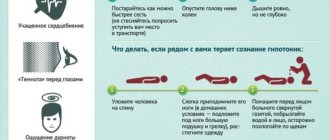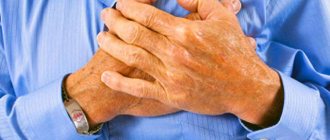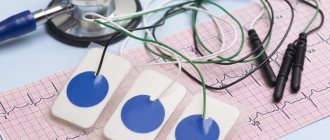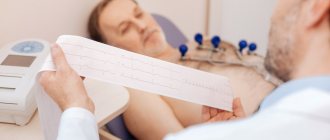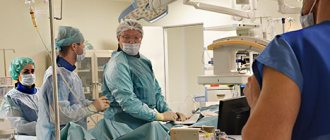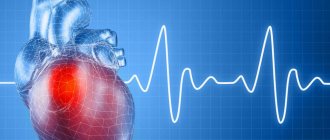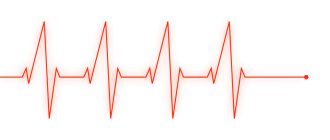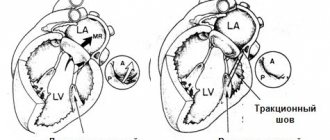Cardiac arrhythmia is a disruption of its normal activity, manifested in a disorder of the rhythm, frequency and sequence of contraction of this organ. Thus, an increase in heart rate is called tachycardia.
Bradycardia is defined as a slow heart rate and pulse less than 60 beats per minute.
Extrasystole is an untimely contraction of the heart, or its individual parts, which affects the overall function of the organ. With atrial fibrillation, the heart contracts chaotically, which leads to organ hypofunction and negative changes in the general condition of the body.
Physical exercises for cardiac arrhythmia in any of its manifestations help restore the functioning of the heart muscle and are prescribed in the complex treatment of these pathologies.
Benefits of physical activity
The benefits of dosed, well-chosen physical activity for arrhythmia are undeniable. Exercises are prescribed to improve the functioning of not only the heart, but also the entire cardiovascular system.
The main element of exercise therapy for arrhythmia is breathing exercises. It is aimed at preventing attacks of arrhythmia, restoring respiratory rhythm, and normal blood circulation.
At the same time, a special complex is created for those suffering from arrhythmia, which eliminates hypertension of the heart muscle and the body as a whole. Exercises are selected by a physical therapy doctor taking into account the characteristics of existing pathologies.
Charger
In the treatment of arrhythmia, exercise is of great importance, which doctors recommend doing in the morning and evening.
The following exercises can be included in the exercise complex:
- Feet shoulder-width apart, pull up on toes. As you inhale, gently raise your arms up, and as you exhale, lower them down.
- Measured bending as you inhale and straightening your arms at the elbows as you exhale.
- Feet shoulder-width apart, hands at the waist. Turn your body to the right and left, while you need to monitor your breathing and smooth movements. Hands spread to the sides.
- Squatting on two legs. Perform carefully, not jerkily, no more than 5-8 times, with pauses for rest.
You need to start and finish the exercise by walking.
Is it possible to play sports?
The heart muscle, like other muscles in the human body, needs training. Arrhythmia, related to diseases of the cardiovascular system, can be treated with physical activity with the right approach and reasonable exercise. For example, light running, just walking, and various types of exercise therapy are very popular. Wherein:
- stimulates glucose absorption;
- the body receives more oxygen;
- additional energy is released;
- the heart begins to work in an economical mode;
- Strength increases and heart rate decreases.
To fulfill all these conditions, regular classes are required, in between which a doctor assesses the patient’s health. The physical form of each patient is determined through special diagnostic procedures.
Exercise therapy in the treatment of arrhythmia
Exercises in the exercise therapy complex, intended for patients with arrhythmia, have not only a healing purpose. This is a gymnastics complex with a strictly dosed load for a specific patient, which takes into account the state of his health, the severity of the disease and the period of development of the disease.
Example exercises in a lying position:
- Flexion and extension of the legs at the ankle joints.
- Flexion and extension of fingers.
- Abduction of arms bent at the elbows. Move your elbows to the sides - inhale, extend your arms along your body - exhale.
- Inhale, extend your arms along your body, palms up. Exhale – raise your arms and reach your knees with your palms, raising your head and tensing.
- Alternately sliding your feet along the bed without lifting them from its surface. Breathing is smooth, without tension.
- Turns with knees bent at the legs, now to the right, now to the left. Breathing is smooth and spontaneous.
- Alternately abducting the right arms and legs to the side, then the left. At the same time, turn your head in the direction of abduction of the limbs.
- Alternately bending and straightening your legs at the knees.
- Lowering and raising your arms up: on inhalation - up, on exhalation - down.
Sitting on a chair:
- Press against the back of the chair. Hands on knees. Taking a deep breath, raise your arms, bent at the elbows to the shoulders. As you exhale, return to the original position.
- Rolling from heel to toe and synchronously clenching and unclenching your fingers.
- Inhaling, raise your arms up, exhaling, lower them down.
- Sliding your feet along the floor without lifting them from its surface.
- Sitting on the edge of a chair and inhaling, move your right arm and left leg to the sides. As you exhale, lower your arm and bend your leg at the knee. Do the same on the other side.
- Hands along the body, alternately lift the left, then the right shoulder. Breathing is smooth and relaxed.
- Inhaling, spread your arms to the sides, exhaling, use your hands to pull the leg bent at the knee towards your stomach and return to the starting position. Do the same for the other leg.
- Sitting on the edge of a chair, place your hands on your belt and take a deep breath. As you exhale, pull your elbows and shoulders inward.
Starting position standing:
- As you inhale, stretch and clasp your hands. As you exhale, lower your arms.
- Tilt the body to the sides while simultaneously abducting the legs in the same direction. Hands raised up.
- Bend your elbows at chest level and spring your arms back.
- Smooth body rotation left and right.
- Inhale with your arms raised up. Lean forward and reach your knees with your hands - exhale.
- Swing your legs forward and backward. Breathing is voluntary.
- Inhale, squat with your arms extended forward and exhale.
Perform all exercises no more than 10 times, monitor your well-being, breathing, and heart rate.
Attention! If you experience discomfort in the heart area during exercise, you should stop exercising and seek advice from your doctor.
Contraindications
Therapeutic exercises for cardiac arrhythmia are contraindicated in the following cases:
- if the heart rhythm is excessively disturbed, such a disturbance often manifests itself after a myocardial infarction; more specific symptoms include paroxysmal tachycardia with frequent regular attacks, atrial fibrillation, which worries constantly, in a chronic form);
- attacks of angina pectoris and abnormal heart rhythm, which manifest themselves during physical effort and are formed as a result of coronary heart disease, problems are investigated using the Holter monitoring method;
if the heart vessels do not allow enough blood to pass through for active movement;- if insufficient blood circulation is caused by heart defects, both congenital and acquired;
- if the degree of heart failure is second or third, with the first it is quite possible to exercise, taking into account your capabilities;
- there are renal disorders that do not allow accelerating metabolism through movement, heavy loads are contraindicated in case of serious liver diseases;
- severe problems in the functioning of the endocrine system, for example, the decompensation stage of type 1 diabetes mellitus;
- if high blood pressure is observed during hypertension - above 160 to 90, you cannot exercise until the situation normalizes, especially while taking antihypertensive drugs;
- aortic or cardiac aneurysm, if there is a threat of rupture;
- inflammation of the walls of the leg veins, which is accompanied by the formation of blood clots (thrombophlebitis).
Arrhythmia may not forgive isometric exercises (movements under tension with resistance), as well as exercises with dumbbells, barbells and other weights. With such exercises, blood pressure increases, and oxygen starvation of the heart muscle also occurs, because the muscle mass that is being trained begins to take on blood, oxygen and nutrients. Also, you should not pump up your abs; under no circumstances do yoga, which is too harmful for the heart due to holding your breath.
There are other obstacles to practicing therapeutic exercises, but they are studied by the attending physician based on studies of functional tests, as well as patient complaints.
Breathing exercises
Breathing exercises are of great importance in the treatment of arrhythmia. Experts have developed many techniques designed to treat various diseases.
One of them is Buteyko breathing exercises. The complex includes several simple breathing exercises:
- Gradual, slow inhalation through the nose for 4-5 seconds. The abdominal muscles are not involved in breathing. Then exhale the same slow way. Perform 10 approaches.
- The inhalation is longer – up to 9 seconds. At the same time, the chest and diaphragm are filled. Then slowly, calmly exhale. Rest for 5 seconds. Perform 11 approaches.
- Between breathing movements, you need to self-massage the bridge of your nose.
- Now inhalation and exhalation are carried out alternately through each nostril separately. Each of them requires 9-10 approaches.
- The next inhalation and exhalation are performed to the entire depth of the chest. They are executed slowly. When there is a pause between inhalation and exhalation, you need to pull in your stomach for 6-8 seconds.
- The last 12 sets are completed within one minute.
- Then normal breathing is restored.
Causes
In children and young people, during the period of active growth and development of all organs and systems, failures of the nervous mechanisms regulating cardiac activity occur. One of these levers is the vagus nerve, which is part of the autonomic nervous system. Its excitement causes a decrease in heart rate. Therefore, a low tone of the vagus nerve during deep inspiration increases the pulse rate, and an increase in tone during exhalation leads to a slowdown.
Arrhythmia associated with the breathing process in children does not require therapy, but provides for the prevention of the development of a pathological rhythm
In adults, respiratory arrhythmia can be caused by the following conditions:
- past infectious diseases;
- organic heart damage during the rehabilitation period (myocardial infarction, rheumatic myocarditis, valvular defects);
- concomitant pathological heart rhythm disturbances (atrial fibrillation, bradycardia);
- prolonged stressful situation;
- taking certain medications;
- nicotine addiction.
Sinus respiratory arrhythmia is generated by a pacemaker localized in the sinus node and is necessarily associated with the breathing process. This distinguishes it from other rhythm disorders, has a favorable course and does not require therapeutic intervention. In childhood and adolescence, such arrhythmia goes away on its own after growth has finished and the functioning of the autonomic nervous system has normalized.
Yoga for arrhythmia
Practical experience in using yoga exercises has shown their effectiveness specifically for cardiac arrhythmia. They combine not only physical exercises that are beneficial for this pathology, but also proper breathing. Yoga helps restore heart rate and stability.
Exercises are performed in a ventilated room, on an empty stomach, preferably in the morning. After classes, it is not recommended to eat immediately, but only after 40-60 minutes.
Attention! The main conditions for performing the exercises:
- The muscles of the body should be relaxed.
- Breathing movements must be performed at a slow, calm pace.
Recommended set of exercises
- Lotus pose. The backs of the hands touch the heels. Take a slow breath, tighten your stomach and bend over so that your forehead touches the floor. Exhaling slowly, sit back in your previous position. At first, this exercise is performed once a day. After 2-3 weeks, you can perform it twice a day, taking into account all the recommendations.
- Lie on the floor or carpet with your head facing east. Alternately, raise your legs: right – inhale, left – exhale. The duration of repetitions is 5-7 minutes at an even, calm pace.
- Slowly raise your arms up and back, while taking a deep breath. Exhalation is accompanied by the return of the hands to the starting position. But at the same time you need to lift your body from the floor and touch your legs with your hands.
- Lying on the floor, make sure that your arms lying parallel to your body do not touch the floor with your elbows. Raise your head and legs from the floor to a distance of 15-20 cm and stay in this position for 2-3 seconds. All this is done with a slow, deep breath. As you exhale, you need to return to the starting position.
- Lying down, bend your knees so that you can grab your ankles with your hands. At the same time, you need to take a deep breath. As you exhale slowly, lower your limbs. This exercise can be repeated 7-8 times and performed twice a week.
Exercise for heart rhythm disturbances
For patients with arrhythmia, it is best to start their morning with exercise. Its daily repetition helps normalize the heartbeat and increases the strength of the heart vessels. A standard home complex is:
- walking in place;
- body turns;
- body tilts;
- circular movements of the pelvis;
- swing your legs.
Each exercise is performed at least 10 times.
It is best to warm up before your first meal or 2-2.5 hours after it. If the load becomes easier each time, then you can increase the number of repetitions. Important to remember! Do not exceed 30 times for each exercise. This is the most optimal amount of load for morning exercises.
Other types of physical activity
For cardiac arrhythmia, physical exercise should be moderate, but daily. Their intensity is increased gradually so that the body can adapt. At first, this may be a short walk with mandatory heart rate monitoring. Then you can alternate walking with running at a slow pace.
When heart rhythm disturbances occur, swimming is very effective, but without stress, which can be done in a pool or in calm natural bodies of water. Riding a bicycle or an exercise bike is not contraindicated. In winter, you can make ski trips on flat slopes without descents or ascents.
(
2 ratings, average: 5.00 out of 5)
